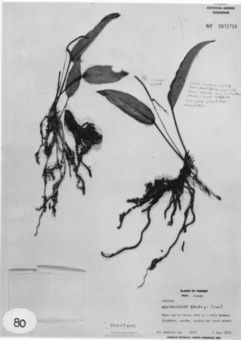




TYPE: Panama. Panama: Cerro Jefe to 1 mi. beyond summit, ca. 100 m. Gentry 3525 (MO 2672710,holotype).
Epiphyte; stems less than 10 cm long, less than 1 cm diam.; internodes short; roots numerous, green, descending, 2-3 mm diam.; cataphylls thin, drying reddish brown, early deciduous.
LEAVES erect; petioles 3-6 cm long, 2-3 mm diam., sulcate adaxially, rounded abaxially; geniculum 3-4 mm long; blades narrowly ovate to ovate-lanceolate, drying moderately thick, narrowly acute to acuminate at the apex, acute at base, 5.5-10 cm long, 1.6-2.7 cm wide, broadest at or below the middle; both surfaces semiglossy, upper surface minutely brownish speckled with short, linear, pale raphide cells, lower surface conspicuously glandular-punctate; midrib raised on both surfaces; primary lateral veins 5-7 per side, moderately obscure above, weakly raised below on drying; interprimary veins weakly raised; collective vein arising from the base, 2-3 mm from the margin, scarcely visible above, weakly raised below.
INFLORESCENCE shorter than the leaves; peduncle slender, 7-8 cm long, ca. 1 mm diam. (dried); spathe thin, green, oblong-linear, 2.7 cm long, 3 mm wide, narrowly acuminate at apex, inserted at 45° angle on peduncle; spadix green, narrowly oblong, 3.5-4.5 cm long, 2 mm diam. near the base, less than 1 mm diam. near apex; flowers (dry) rhombic, 2-2.2 mm long, ca. 1.5 mm wide, the sides moderately straight, 2-3 flowers visible in the principal spiral, 4-5 flowers visible in the alternate spiral; tepals semiglossy, lateral tepals 1.2-1.3 mm wide, the inner margin moderately straight, the space between the tepals elongated slightly in the direction of the axis, 0.7-0.9 mm long; pistil not emergent; stamens persistent after anthesis; anthers ca. 0.2 mm long; 0.4-0.6 mm wide, held at the level of the tepals around the pistil; thecae subcircular to broadly elliptic, divergent at ca. 180° angle from one another.
INFRUCTESCENCE not seen. Fig. 80.
Anthurium gentryi is known only from the type collected in Panama Province near the top of Cerro Jefe in premontane rain forest at about 100m.The species is a member of section Porphyrochitonium and is distinguished by its small size, its narrowlly ovate to ovate-lanceolate Blades Vhal are eglandular with pale raphide cells visible on the upper surface and glandular-punctate on the lower surface, and especially by its very slender, green spathe and spadix with anthers that remain exserted.
Relatively few members of this section retain their stamens above the tepals after anthesis (especially after being dried) and none that do, such as Anthurium terryae, are in the least confused with A. gentryi.
The species is named in honor of Dr. Alwyn H. Gentry of the Missouri Botanical Garden who collected the type specimen.

Panama: near top of Cerro Jefe, Gentry JS2S (MO).